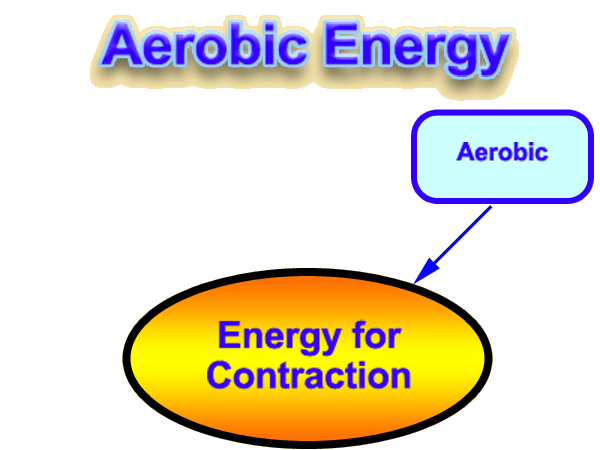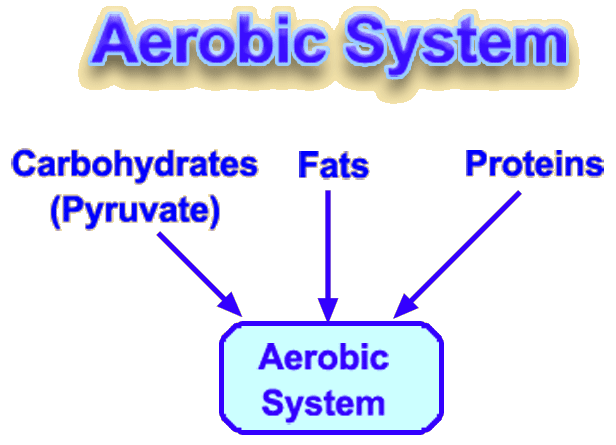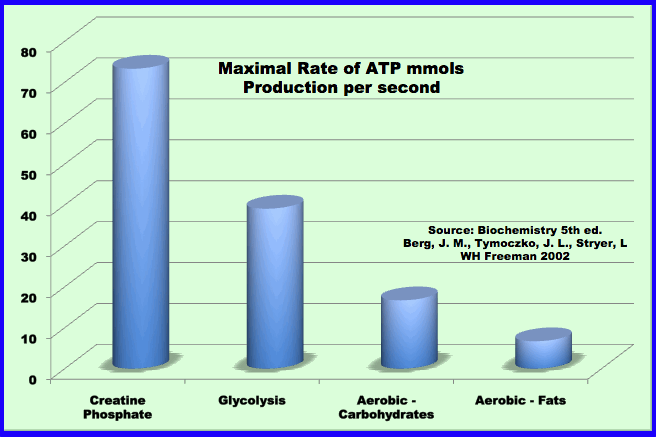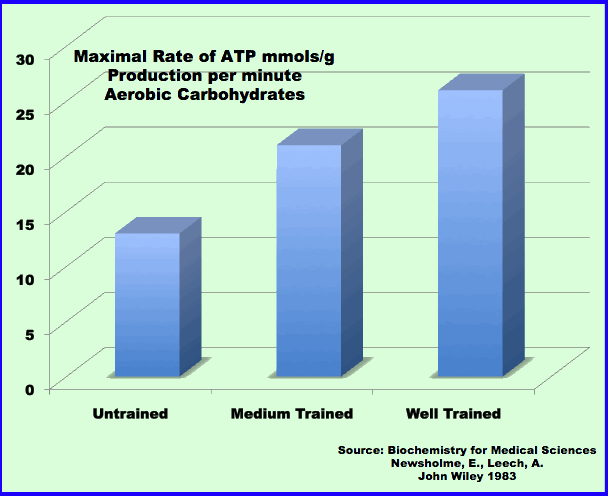Cycling Performance Presentation - San Francisco
Endurance Events and Lactate Testing
With Emphasis on the Triathlon
6 of 19
Why does every triathlete want a strong
aerobic system?
Aerobic Energy
The answer to the question above is that the aerobic system provides nearly all the energy during an endurance event and the stronger it is for each discipline in the triathlon, the faster a triathlete or any endurance athlete will be during a race. But there is one caveat to this and that is the strength of the anaerobic system. As you read on in these modules you will come to understand how one trains both energy systems is the key to success.
If one want to be a successful triathlete, it is essential to understand how each energy system works and more importantly how to train each optimally.
There is just one aerobic system. It requires oxygen for usage; hence, the name (from Greek aero meaning air). There are two anaerobic systems for rebuilding ATP. The term “anaerobic” is used to mean that oxygen is not used in either system. It does not mean as some have thought that it is only used when there is no oxygen available. Anaerobic systems are often used when there is plenty of oxygen.

The aerobic system can utilize three different fuels: fats, carbohydrates and proteins. The bulk of the energy will come from fats and carbohydrates, and of these two, fats provide most of the fuel for daily activity. Protein as a fuel represents only a very small contribution.
When the aerobic system uses carbohydrates as fuel, it is in the form of pyruvate. Since pyruvate does not exist in the muscle or blood stream to any great extent, the carbohydrate that is actually the fuel for the aerobic system is lactate. Lactate is quickly converted to pyruvate just before being used as fuel for aerobic energy. So in the chart below we really should think lactate and not pyruvate.

Carbohydrates are broken down much faster than other fuels such as fats and thus provide quicker aerobic energy for intense activity. Here is a chart comparing the various fuels for contraction and how fast they produce energy. You can see that aerobic metabolism using carbohydrates produces energy at over twice the rate as aerobic fat metabolism.

Carbohydrates (in the form of lactate) are thus the most desirable fuel for endurance sports because they lead to a faster rebuild of ATP and enable faster contraction and a speedier race for the athlete. But the supply is limited. There are only enough carbohydrates stored in the muscles to enable intense aerobic exercise for about 90-100 minutes. There is enough fat stored in the body to fuel slower aerobic exercise for several days. The proportion of fats and carbohydrates used during competition depends upon the athlete's conditioning level and the speed required. The following chart indicates that the rate of energy production from carbohydrates is higher for well-trained male endurance athletes compared to medium-trained and untrained males. .

The reason why fats metabolize slower than pyruvate/lactate is under debate. But at high intensity exercise few, if any, fats are being used for aerobic metabolism. And if the muscles are glycogen-depleted as in the late stages of a marathon, the runners must go slower. They cannot will their legs to go any faster no matter how hard they try. They have no carbohydrates for metabolism unless they take some during the race and even these carbohydrates cannot reach the muscles and be metabolized as fast as stored glycogen can.
The aerobic system is by far the most important source for energy. The reason why the anaerobic system was introduced first is because it is important to understand the dual role of lactate: an output of the anaerobic system and the most important fuel for the aerobic system. For a long race, the pyruvate/lactate for fuel is limited and the muscles will use a large amount of fats for fuel. But as we just noted, the more carbohydrates available, the faster one will race. And since the carbohydrates come only from the anaerobic system, it is a misnomer to say that even an Ironman is a totally aerobic race. Without the anaerobic system providing the carbohydrates and some high-energy molecules in addition to the small amounts of ATP, aerobic metabolism would be much slower.
There are no negative byproducts of the aerobic system: only water and carbon dioxide which an athlete sweats and exhales. However, there is one negative, heat, and this has to be carefully considered during training. As we use the aerobic system at high levels a lot of heat is generated in the cells, and this heat accelerates the breakdown of the cells. Too much breakdown and the athlete will lose aerobic capacity. That is why training at or above threshold must be limited in a sensible training program. We find that many triathletes believe that finding and training at the threshold is the most important aspect of lactate testing. We disagree because training near the threshold breaks down too much, often causing a loss of aerobic capacity not a gain. So triathletes should be careful with their training intensity because it can have negative effects if not carefully controlled especially the better they are.
How to Train the Aerobic System - The Secret is Training Fiber Types
In the late 1980's and early 1990's Jan Olbrecht realized that the secret to training the muscles was a multi-fold process but two essential steps were
First, in order to train all the muscle fibers aerobically (the main objective is to increase the mitochondrial content of each) different stimuli are needed for each type of muscle fiber. Fast twitch fibers do not respond to the same training approach as slow twitch fibers do. So it is necessary to train each differently.
And to make it even more complicated, what works with one type of fiber may be detrimental with another. So training has to be a constant give and take as one slowly builds each type of fiber aerobically.
Second, the anaerobic system is a key element is accessing the aerobic system. The aerobic system provides nearly all the energy in an endurance event but much of this energy is unavailable because there is an interaction of the aerobic system with the anaerobic system. Thus, the anaerobic system must also be trained so as to let the body utilize the aerobic energy source to its optimal level. Jan's mentor at the Sports University in Cologne, Alois Mader, discovered how the two systems interact and how each is dependent on the other for optimal performance whether the event lasts at little as 40 seconds or longer than 8 hours as in the Ironman.
In the mid 1990's Jan wrote a book describing this method of training in the context of swimming and published it in Belgium in Dutch. In 2000 he published it in English and titled it the Science of Winning.
Everyone has three pure muscle fiber types (slow twitch, fast twitch oxidative and fast twitch glycolytic) and hybrids of these three fiber types. Some classifications have just two fiber types, slow and fast twitch or even up to four types as the fast twitch are classified in different ways. Some say that all muscle fibers are mixtures and there are literally hundreds of different fiber types forming a continuum from one pure type to another.
In humans, a muscle is composed of different fibre types in variable proportions and this composition is some times referred to as a mosaic as a slow twitch fiber could be right next to a fast twitch fiber in the same muscle. The mitochondria content of each type of fiber is different but each is capable of aerobic metabolism even if they are fast twitch glycolytic fibers which are considered the lowest in term of aerobic energy potential. But aerobic energy is produced in the mitochondria of these cells so the density of mitochondria is important for aerobic capacity even in these so call non aerobic fibers.
So training all fibers to increase their aerobic capacity is essential for an optimal performance by an endurance athlete. Also each type of muscle fiber has to be trained differently and as Olbrecht found out, the optimal training of one type of fiber may actually be harmful to the training of another fiber type. Fast twitch fibers respond better for aerobic development to high intensity exercise but this has a negative effect on slow twitch fibers. See module on training paces.
To make it even more complicated, there is some evidence that one fiber type can turn into the other with training over time. This is an on going debate. See
Ingalls, C. P. (2004). "Nature vs. nurture: can exercise really alter fiber type composition in human skeletal muscle?" Journal of Applied Physiology 97(5): 1591-2.
There is a growing research body based on DNA and other evidence that people respond differently to training that is trying to build aerobic capacity. Here are four articles that review the latest findings on this topic.
Timmons, J. A., E. Jansson, et al. (2005). "Modulation of extracellular matrix genes reflects the magnitude of physiological adaptation to aerobic exercise training in humans." BMC Biology 3: 19.Hautala, A. J., A. M. Kiviniemi, et al. (2006). "Individual differences in the responses to endurance and resistance training." European Journal of Applied Physiology 96(5): 535-42. (adaptation)
Timmons, J. A., S. Knudsen, et al. (2010). "Using molecular classification to predict gains in maximal aerobic capacity following endurance exercise training in humans." Journal of Applied Physiology 108(6): 1487-96.
Timmons, J. A. (2011). "Variability in training-induced skeletal muscle adaptation." Journal of Applied Physiology 110(3): 846-53.
Based on these findings it may be only a matter of time before every elite athlete's DNA will be scrutinized for their ability to adapt to certain stimuli. But more importantly, it is important for an athlete to recognize that what works for his fellow athlete might not work for him or her and that a different training approach is required.
And as we continue to recommend throughout this site, the anaerobic capacity must be assessed and trained too. The training of this capacity to the optimal level may have negative effects on aerobic capacity unless closely monitored and assessed. Jan Olbrecht discusses this in the, The Science of Winning and we discuss this briefly in our Thresholds page and on the page on training paces.
Importance of the Aerobic System
In summary, the aerobic system is the most important of the energy systems and provides most of the energy for any race over 2 minutes. It is extremely important for the triathlon, both for training and for the race itself. A strong aerobic system not only provides energy for the race but enables the athlete to raise the intensity and volume of training. Also a strong anaerobic system during the training period enables the athlete to complete more intense and longer workouts than would a low anaerobic capacity. However, during a race a high anaerobic capacity will inhibit performance.
The aerobic system is more trainable than the anaerobic system and improvements or declines in the aerobic system are more easily measured. This is another reason why more attention is paid to the aerobic system. Aerobic energy is produced in small subsections of the cell called mitochondria. These are complicated little biological entities and the normal muscle cell has about 2% of its volume in mitochondria. World class endurance athletes might have up to 10% of their cells composed of mitochondria. So essentially they have five times as many little energy factories as the average person and this is why they can run so fast for so long.
In later modules on energy metabolism (beginning with Anaerobic Mechanism, module 14) the interaction of the aerobic and anaerobic systems is considered. You will see how each is the gatekeeper for the other. For long races the anaerobic system is the gatekeeper for the aerobic system. For short races, the aerobic system is the gatekeeper for the anaerobic system.
Continue on to module 7 which discusses a framework for triathlete testing and the types of tests.
